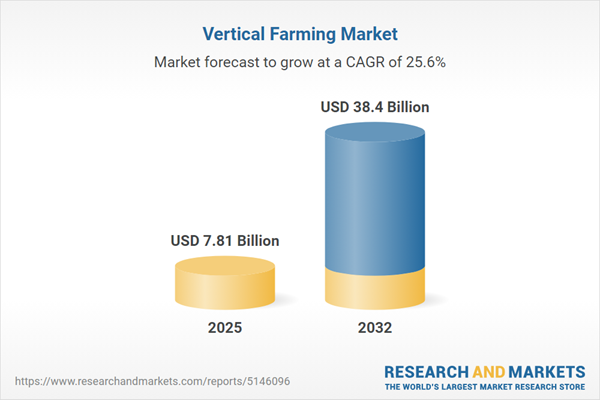Speak directly to the analyst to clarify any post sales queries you may have.
Vertical farming is transforming controlled environment agriculture, enabling organizations to address complex challenges in global food production. Senior leaders evaluating resilient, tech-led strategies will find vertical farming pivotal for supply chain agility and sustainability.
Market Snapshot: Vertical Farming Market Overview
The Vertical Farming Market grew from USD 6.20 billion in 2024 to USD 7.81 billion in 2025, and is forecast to reach USD 38.40 billion by 2032, reflecting a robust CAGR of 25.59%. This sector is propelled by increasing urbanization, demand for consistent local food supply, and the growing imperative to use land and water more efficiently. Controlled environment agriculture techniques and the adoption of integrated automation, LED lighting, and data-driven insights are rapidly advancing vertical farming's scale and capabilities.
Scope & Segmentation
This report provides comprehensive analysis of the global vertical farming market, covering offerings, crop types, systems, technology, and regional dynamics. Segmentation highlights include:
- Offering: Product (control systems, equipment and machinery, seeds and nutrients), Service (consulting, maintenance, support and training)
- Lighting Type: Fluorescent, HPS, LED
- Crop Type: Flowers, Fruits (berries, citrus, tomatoes), Herbs (basil, mint, parsley), Leafy Greens, Microgreens (broccoli sprouts, mustard greens, sunflower shoots)
- System: Aeroponics (high pressure, low pressure), Aquaponics, Hydroponics (deep water culture, drip system, ebb and flow, nutrient film technique)
- Installation Type: Greenhouse, Indoor
- End-User: Commercial, Research, Residential
- Region: Americas (North America: United States, Canada, Mexico; Latin America: Brazil, Argentina, Chile, Colombia, Peru), Europe, Middle East & Africa (Europe: United Kingdom, Germany, France, Russia, Italy, Spain, Netherlands, Sweden, Poland, Switzerland; Middle East: United Arab Emirates, Saudi Arabia, Qatar, Turkey, Israel; Africa: South Africa, Nigeria, Egypt, Kenya), Asia-Pacific (China, India, Japan, Australia, South Korea, Indonesia, Thailand, Malaysia, Singapore, Taiwan)
- Key Companies: AeroFarms, Inc., Bowery Farming, LLC, Plenty Unlimited Inc., Infarm GmbH, Gotham Greens, LLC, AppHarvest, Inc., BrightFarms, Inc., Vertical Harvest, LLC, Spread Co., Ltd., Iron Ox, Inc.
Key Takeaways for Decision-Makers
- Vertical farming enables consistent, year-round crop production, leveraging advanced automation and data analytics for optimized yields and reduced waste.
- The convergence of precise LED lighting, IoT sensors, and machine learning is streamlining operational efficiency and driving innovation in plant growth methodologies.
- Strategic industry partnerships are accelerating commercialization, enabling faster adoption across major regions and creating vertically-integrated food supply systems.
- Flexible system architectures and diverse crop options allow stakeholders to manage volatility in input availability, supporting business continuity.
- Growth in the sector is complemented by policy support, investor interest, and expanding use of renewable energy in closed-loop systems, positioning vertical farming for sustainable scale.
Tariff Impact on the United States Vertical Farming Ecosystem
Recent tariff changes on critical imported components have increased capital and operational costs for U.S. vertical farming ventures. Sector participants are responding by shifting toward domestic manufacturing, fostering local supplier partnerships, and reprioritizing high-margin crops with shorter growth cycles. Innovative resource efficiency investments and strategic material sourcing are enhancing market resilience despite ongoing pricing pressures.
Methodology & Data Sources
The research methodology integrates primary interviews with senior executives and technical experts, supported by a review of regulatory documents, industry reports, and academic literature. Supply chain mapping, competitive benchmarking, and scenario analysis underpin the report's conclusions, with data triangulation applied to enhance reliability.
Why This Report Matters
- It delivers actionable intelligence on technology trends and competitive positioning to guide strategic investment and operational planning.
- Detailed segmentation enables identification of high-potential crops, systems, and regions for scalable growth.
- Analysis of policy, tariff, and innovation dynamics supports stakeholders navigating market entry and expansion pathways.
Conclusion
This report provides decision-makers with an in-depth understanding of vertical farming’s evolving landscape, technological advancements, and market opportunities. Focused recommendations support long-term competitiveness in sustainable agriculture and urban food production.
Additional Product Information:
- Purchase of this report includes 1 year online access with quarterly updates.
- This report can be updated on request. Please contact our Customer Experience team using the Ask a Question widget on our website.
Table of Contents
3. Executive Summary
4. Market Overview
7. Cumulative Impact of Artificial Intelligence 2025
Companies Mentioned
The companies profiled in this Vertical Farming market report include:- AeroFarms, Inc.
- Bowery Farming, LLC
- Plenty Unlimited Inc.
- Infarm GmbH
- Gotham Greens, LLC
- AppHarvest, Inc.
- BrightFarms, Inc.
- Vertical Harvest, LLC
- Spread Co., Ltd.
- Iron Ox, Inc.
Table Information
| Report Attribute | Details |
|---|---|
| No. of Pages | 194 |
| Published | November 2025 |
| Forecast Period | 2025 - 2032 |
| Estimated Market Value ( USD | $ 7.81 Billion |
| Forecasted Market Value ( USD | $ 38.4 Billion |
| Compound Annual Growth Rate | 25.5% |
| Regions Covered | Global |
| No. of Companies Mentioned | 11 |









